Not To Be A Decolonialist Marxist But The Concept Of Emotionality And Compassion Being Incompatible,
Not to be a decolonialist marxist but the concept of emotionality and compassion being incompatible, the opposite, and unmixable with intelligence is very fucking white. :/
More Posts from Green-notebooks and Others
TIL the “fresh is best” culture led consumers to wrongly see frozen produce as lower quality. It turns out frozen fruit & veg are equally nutritious. The freezing process slows nutrient loss which occurs after harvesting. Researchers found no real nutritional differences overall.
via reddit.com
sustainability as a concept done on an individual basis shouldn’t be framed as planet saving because it’s. not. you can’t save the earth by planting your own tomatoes, because the destruction of the earth is due to corporations
what you CAN do is use individual sustainability to gain a level of independence from capitalism for yourself and for your community through things like sharing grown food
Look, your plastic straws are only a negligible contribution to oceanic plastic pollution. Japan has backed out of all of its clean energy goals since Fukushima and is importing thousands of tons of fossil fuels to make up for it. The lithium mining processes required to make your hybrid car make its environmental benefits basically nonexistent. Food waste has much more to do with governmental regulations on spoilage and consumer demand for cosmetically perfect produce than you forgetting about the kale in your vegetable crisper.
The world is made of complex problems and the simple answer basically only exists to make you feel good about yourself
i learned that Binghamton University researchers have been working on a self-healing concrete that uses a specific type of fungi as a healing agent. When the fungus is mixed with concrete, it lies dormant until cracks appear, when spores germinate, grow and precipitate calcium carbonate to heal the cracks (x)

Can't afford to buy things for your garden?
*Re-posting, with new information
A store-bought bag of topsoil, a roll of landscaping fabric, or a bag of cedar chips doesn’t go very far if you have a large garden or a very limited budget. Here are some ways to create the materials you need for a beautiful, organic, productive garden, by both re-directing household waste, and foraging in your local area. I use a lot of these tricks in my garden to make it almost completely free for me to continue growing new things, and expanding the workable area every year!
For soil
Save your food scraps to create a rich compost for growing veggies and amending your soil. There are numerous options for every size of dwelling and yard. Small space solutions such as Bokashi and vermicompost work indoors and don’t produce bad smells, so you can keep them underneath the sink.Worm towers, compost heaps, and outdoor compost bins are a great solution if you have more space. The more you add, the more rich, nutritious material you can make for your garden. I like composting because it means I don’t have gross smelly garbage bags to deal with, because food waste is diverted. It seems like a lot of work at first, but it actually saves time, money, and transportation.
Seaweed or kelp is one of the best things for your garden, with over 70 essential nutrients, and acting as a weed barrier and a moisture-retentive mulch. I collect seaweed nearby on the beach with my bike trailer, or, when I go for a walk I bring a little home with me each time. It’s an absolute miracle for your soil.

Worm tower
Fertiliser
There are three things that are essential for plant growth. These are nitrogen for leaves and vegetation (N), phosphorus for roots and shoots (P), and potassium for water movement, flowering, and fruiting (K). Commercial fertilisers will give the relative concentrations of each of these compounds with and “NPK” rating. Plants like tomatoes also need calcium to produce healthy fruit. You can create amendments for your garden and soil at home so that you do not have to purchase fertiliser.
For nitrogen
Grass clippings contain 4% nitrogen, 1% phosphorus, and 2% potassium (NPK = 4-1-2).
Human urine contains 12% nitrogen, and it’s sterile. Dilute before adding directly to plants.
Legumes such as beans, clover, peanuts, and alfalfa fix inorganic nitrogen into the soil with mycorrhizal organisms and nodules on their root systems. Plant these crops every few years in rotation with others to renew the soil organically.
For phosphorus
Human urine is also a great source of phosphorous and trace amounts of potassium.
Ground up bones or shells add a slow-release phosphorous to the soil
Had a baby recently? Bury the placenta in the garden.
For potassium
Hardwood ashes
Composted banana peels
For calcium
Break down all of your eggshells, or seashells you have found, in a plastic bucket, using vinegar. This creates a soluble calcium solution you can add to a watering can.
Soil Acidity/Alkalinity
Many plants are particular about what the soil pH should be.
To make soil more acidic: add oak leaves, pine needles, leaf mulch, urine, coffee grounds or sphagnum.
To make soil more alkaline: add wood ash, shell, or bone.
Mulch
Mulch is decomposing organic matter that adds nutrition to the soil, while simultaneously keeping out weed growth and retaining moisture. It also attracts worms, fungi and other beneficial creatures to your soil. Free sources of mulch include:
Leaves
Garden waste
Grass clippings
Straw (often straw bales are given away after being used for decoration in the fall. You can also plant vegetables directly in straw bales using a technique called straw bale gardening).
Wood chips (if you can borrow a wood chipper after you’ve collected some wood you can have attractive wood mulch for free)

Straw bale garden
Landscaping fabric
When mulch isn’t enough to keep the weeds down, many people opt for landscaping fabric. It can be quite expensive and inorganic-looking. Free solutions that both attract worms and can be replaced in small segments as they break down include:
Newspaper*
Cardboard*
Egg cartons*
Printer paper, looseleaf, etc. in thick layers*
*try to make sure you are using paper that has vegetable-based dyes, so you aren’t leeching toxins into the soil.
Soil density/drainage
If your soil is compacted and you have plants that require low levels of water, or excellent drainage, add sand. I don’t recommend stealing it from the beach, but ask around and you’d be surprised at how easy it is to get for free. Sawdust also improves drainage. Adding organic matter and mulch encourages worms, who also till and aerate compacted soil.
If the area still needs drainage, dig a hole and fill it with bricks or rocks to create a “dry well”
For drainage in pots, add crushed bricks, terra cotta pot fragments, packing peanuts, small stones, marbles, orsand to the bottom under the soil layer. I find these in construction sites, on craigslist, or at flea markets.
Pots and growing containers
If you have space, raised beds are a great no-dig way to establish growing space. If you are pressed for space (like working on a balcony) there are many cheap or free options for container gardens.
Creating raised beds allows you to build up the soil without digging. Free ways to do this include using rocks or lumber (like my DIY “lasagna garden” made with the sheet composting technique), using the “wattle“ method with sticks and posts you have found, using discarded straw bales, old bricks,paving stones, cinder blocks or really anything else you have lying around.
Hugelkutur raised beds, which fix carbon and provide drainage, can be made by stacking sticks and untreated wood, and then piling soil or compost over it. (Thanks milos-garden)
Rubber tire gardens retain heat in the night and allow for great drainage. They can also be painted in fun ways.
Herb spirals (here is mine: 1, 2, 3) can be built with stones, bricks, and other found materials.
I often use old cooking pots, barbecues, teapots, or other found objects as planters.
Making wooden planters is easy, and scrap or salvaged wood is also easy to come by. I’m not a fan of using wooden pallets for DIY projects, but they are also a free source of lumber for things like planters.
If you can track down peat moss, cement, and vermiculite, you can make an easy Hypertufa planter in whatever shape you would like, provided you have a form in which it can dry.
I’ve made hanging gardens out of soda cans.
You can build a self-watering container with a 2L pop bottle.
Start seeds in eggshells
Make biodegradable pots out of newspapers.
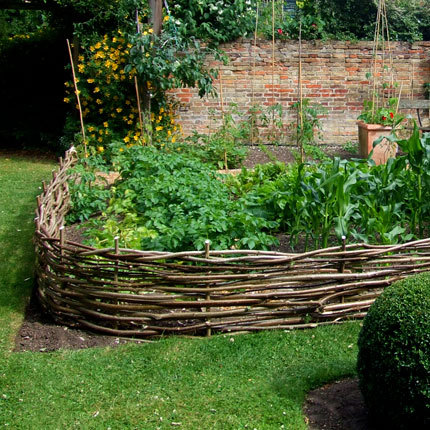
Wattle raised beds

Rubber tire gardens

Hugelkultur

An herb spiral
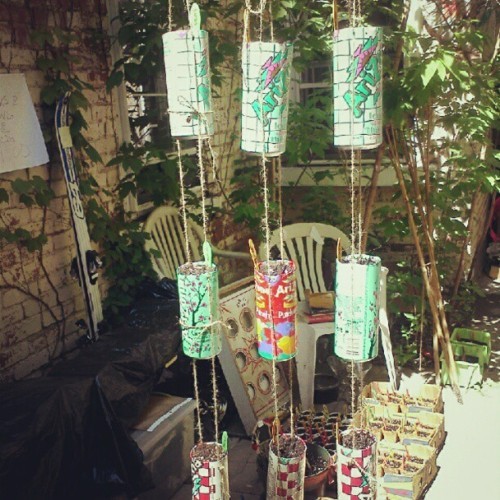
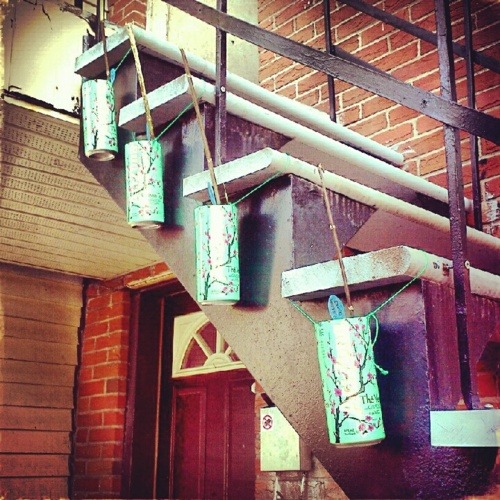
Hanging gardens in cans (2)
Trellises and supports
Many plants need external support, such as stakes of trellises, to thrive.
Rebar can almost always be salvaged cheaply or free and makes a great trellis, arch, or purgola
Build trellises and supports out of the pliable young stems of plants like willow
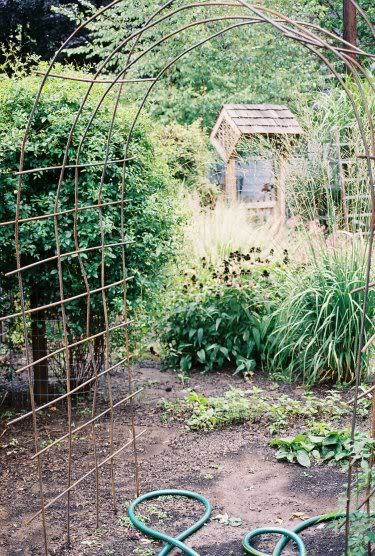
Rebar trellis/arch

Living willow arch/trellis
Paving
Paving often requires a foundation of sand or another stable and well-drained substrate, and a covering of stones, bricks, or other weatherproof elements. Slowly collect stones over time, or free paving stone fragments to create a mosaic-type walkway. Often people give these things away on craigslist. I made a patio and fireplace out of free salvaged bricks, for example.

Salvaged garden walkway
Greenhouses and cold frames
Here is a gallery of greenhouses made out of salvaged windows and doors
A cold frame is easy to make with salvaged lumber, and plastic sheeting.
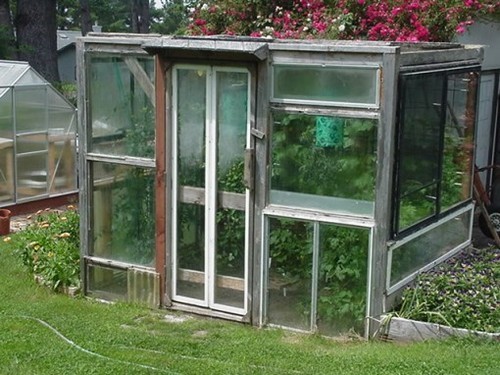
Window greenhouse
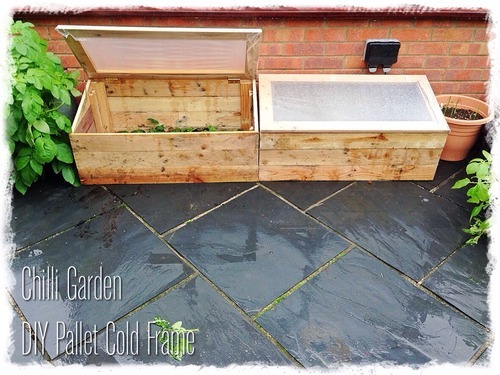
Palet cold-frame
Seeds and plants
Swap seeds with other gardeners
If you see a plant you like at someone’s house, ask for seeds or cuttings
Save seeds every year and build a library of options. Here is a great guide to seed saving.
Save seeds from foods you like from the grocery store: consider growing peanuts, ginger, garlic, peppers, or a walnut tree: all of these and more can be planted from store-bought produce.
Learn to take cuttings. There is a tonne of info on the web about basic cutting propagation, layering, (like I do with rhododendrons) air layering, and numerous other techniques to take clones of plants you like. This saves going to a nursery and shelling out big bucks for all the variety you want.
For cuttings, willow tea and honey are great rooting hormones/antiseptics/anti-fungal agents, which can save you $40 if you were thinking of buying commercial rooting hormone.
You can root cuttings in a potato! (See my methods for rooting “borrowed” plants here)
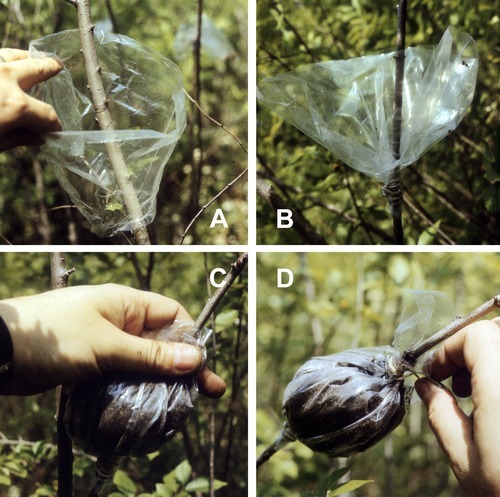
Air layering
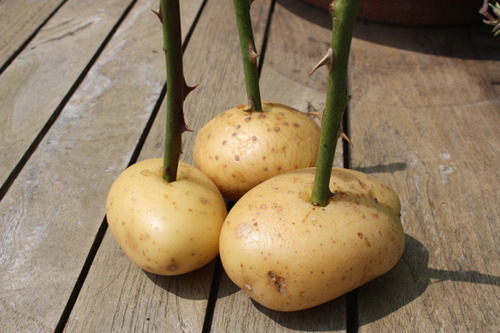
Rooting cuttings in potatoes
—-
I hope this helps you build your garden outside of the usual capitalist channels! It can be a cheap or free hobby if you are willing to think outside the box, and maybe put up with things that don’t look as clean or crisp as a hardware store catalogue. If you have any further ideas, please add them! The more information the better.

“Between 1992–2003, $14.4 billion was spent in total in the 109 countries studied…That investment resulted in a 29 percent-per-country average decrease in the rate of biodiversity decline…”
This is one of the first large-scale studies to show that investment in conservation really does work. The study also examined how conservation dollars could be spent most effectively in different locations to slow biodiversity loss.
What if, instead of tropical fish tanks, you had a live video stream of a section of coral reef? Every time you “fed” the fish, it would be a button you clicked to donate to the reef’s protection. As more you “feed” the fish, you’re granted more access to other reefs. And nightvision cameras are included so you can see your wild pets at night too without disturbing them with harsh lighting.

Perfect for folks like me who love fish, but do not love cleaning tanks.
How much longer until the utopic Solarpunk future where Capitalism is dead and we all live in ecologically sustainable high-tech forest cities? Asking for a friend.





I’m trying to write a personal diary about my gardening activities.
do you know what I want? I want a game where you play the forces of overgrowing nature, where you systematically destroy the mansion in the GardenScapes game I keep seeing ads for.
like. let me grow grass up through those perfect tiled patios and algae in the fountain and vines up through those marble statues and pillars cracking them in half. let me plant wildflowers and berries and lure birds and butterflies into the yard.
let me grow trees up through the roofs and on top of those perfect stone walls and crack them and break them down
I will DESTROY IT. WITH NATURE.
no microtransactions, no timed building.
you plant seeds and wait for them to grow, then train them over the top of the walls and wrap around the statues
attract birds and squirrels with water and nesting areas and they’ll bring you seeds
the goal of the game is to get it so quiet and wild that you can support entire ecosystems in what used to be a super colonial classist mansion
the hardest thing in the and is to lure and be able to support a cougar, because it requires the entire property to be FOREST with deer and berry bushes and a stream
there’s also a hidden plot about the rest of the world
it’s the end of oil and the entire world has actually managed to switch over to clean energy, everyone lives in gorgeous green cities and close-knit small towns with super efficient greenhouse agriculture with solar and wind power
all the suburbs and manor-house things have been abandoned because they’re too far away from population centres and there aren’t any cars
there are electric public rail systems in all the cities and between population centres and most people bike and use hover-board drones for transportation
full-on solarpunk
you find this out because there’s a subplot of finding and repairing an iPhone with bits of tech you find in the rubble of the manor house, which you can then access a couple news sites on
but that’s kinda the hidden ending
there are a couple more things like that as well, hidden, like the story of the family who lived in the manor (they were all dicks and economically terrible people which adds even more catharsis to the destruction), some campers that come through if you fit a requirement for scenery, that kind of thing)
-
 hagelliot reblogged this · 10 months ago
hagelliot reblogged this · 10 months ago -
 mascarponx liked this · 1 year ago
mascarponx liked this · 1 year ago -
 ensrensage liked this · 1 year ago
ensrensage liked this · 1 year ago -
 burana006 reblogged this · 1 year ago
burana006 reblogged this · 1 year ago -
 thefoxwell liked this · 1 year ago
thefoxwell liked this · 1 year ago -
 daniyadrafts liked this · 2 years ago
daniyadrafts liked this · 2 years ago -
 schniggles liked this · 2 years ago
schniggles liked this · 2 years ago -
 jackkal liked this · 2 years ago
jackkal liked this · 2 years ago -
 oh-and-this reblogged this · 2 years ago
oh-and-this reblogged this · 2 years ago -
 alas-ihavenolife liked this · 2 years ago
alas-ihavenolife liked this · 2 years ago -
 shamebats liked this · 2 years ago
shamebats liked this · 2 years ago -
 avo-kat reblogged this · 2 years ago
avo-kat reblogged this · 2 years ago -
 deathbars reblogged this · 2 years ago
deathbars reblogged this · 2 years ago -
 deathbars liked this · 2 years ago
deathbars liked this · 2 years ago -
 dacergirl369 liked this · 2 years ago
dacergirl369 liked this · 2 years ago -
 blueberrybonbons reblogged this · 2 years ago
blueberrybonbons reblogged this · 2 years ago -
 blueberrybonbons liked this · 2 years ago
blueberrybonbons liked this · 2 years ago -
 oh-and-this liked this · 2 years ago
oh-and-this liked this · 2 years ago -
 durd reblogged this · 2 years ago
durd reblogged this · 2 years ago -
 starshipheartofg-erti reblogged this · 2 years ago
starshipheartofg-erti reblogged this · 2 years ago -
 starshipheartofg-erti liked this · 2 years ago
starshipheartofg-erti liked this · 2 years ago -
 bop--it liked this · 2 years ago
bop--it liked this · 2 years ago -
 take-me-not-my-otp reblogged this · 2 years ago
take-me-not-my-otp reblogged this · 2 years ago -
 take-me-not-my-otp liked this · 2 years ago
take-me-not-my-otp liked this · 2 years ago -
 alienspacequeen reblogged this · 2 years ago
alienspacequeen reblogged this · 2 years ago -
 morikka liked this · 2 years ago
morikka liked this · 2 years ago -
 cosmos-chaos reblogged this · 2 years ago
cosmos-chaos reblogged this · 2 years ago -
 cosmos-chaos liked this · 2 years ago
cosmos-chaos liked this · 2 years ago -
 oreocannibalism liked this · 2 years ago
oreocannibalism liked this · 2 years ago -
 weresehlat liked this · 2 years ago
weresehlat liked this · 2 years ago -
 ghostpoetics liked this · 2 years ago
ghostpoetics liked this · 2 years ago -
 thecolorofthegame liked this · 2 years ago
thecolorofthegame liked this · 2 years ago -
 thecolorofthegame reblogged this · 2 years ago
thecolorofthegame reblogged this · 2 years ago -
 supremeoverlordofdarkness liked this · 2 years ago
supremeoverlordofdarkness liked this · 2 years ago -
 the-grey-hunt reblogged this · 2 years ago
the-grey-hunt reblogged this · 2 years ago -
 thawinoakenshield reblogged this · 2 years ago
thawinoakenshield reblogged this · 2 years ago -
 sharpdistances liked this · 2 years ago
sharpdistances liked this · 2 years ago -
 fr3nch-fr135 liked this · 2 years ago
fr3nch-fr135 liked this · 2 years ago -
 unspecifiedsalt reblogged this · 3 years ago
unspecifiedsalt reblogged this · 3 years ago -
 clementine-peach liked this · 3 years ago
clementine-peach liked this · 3 years ago